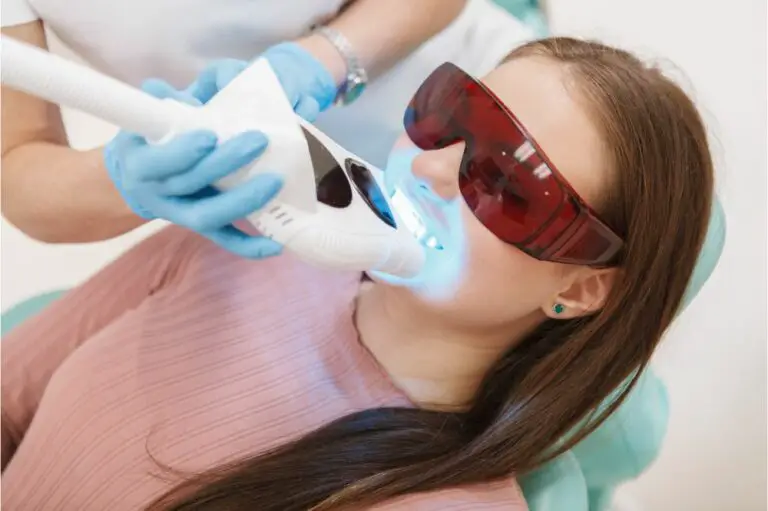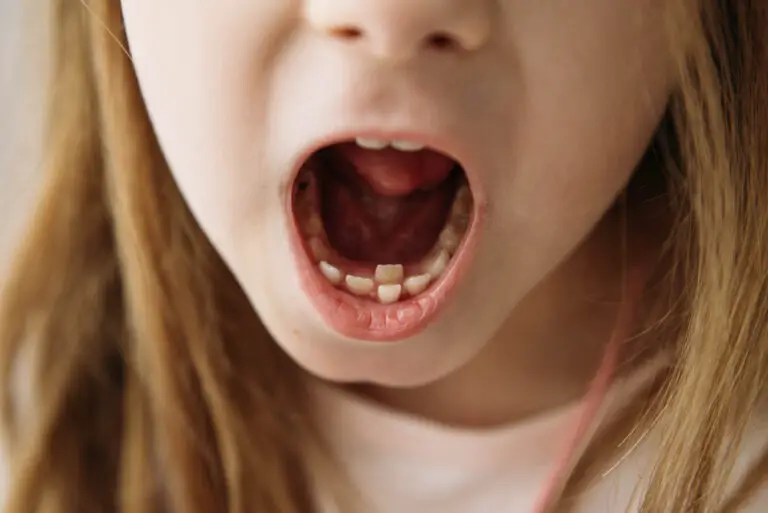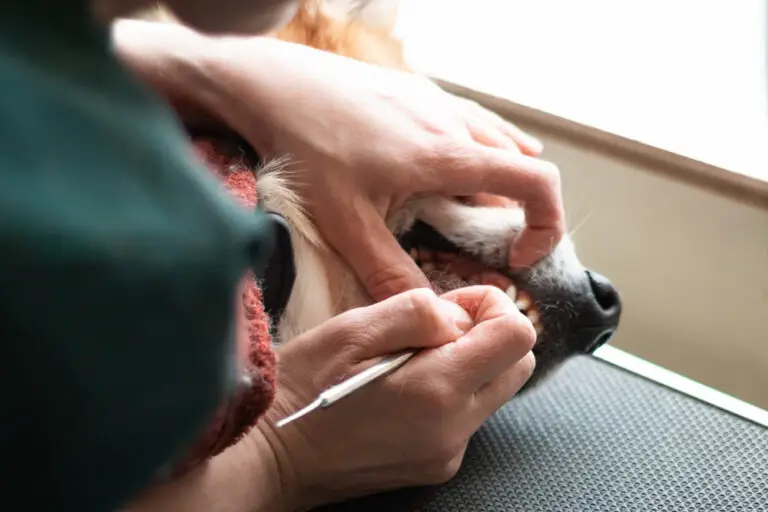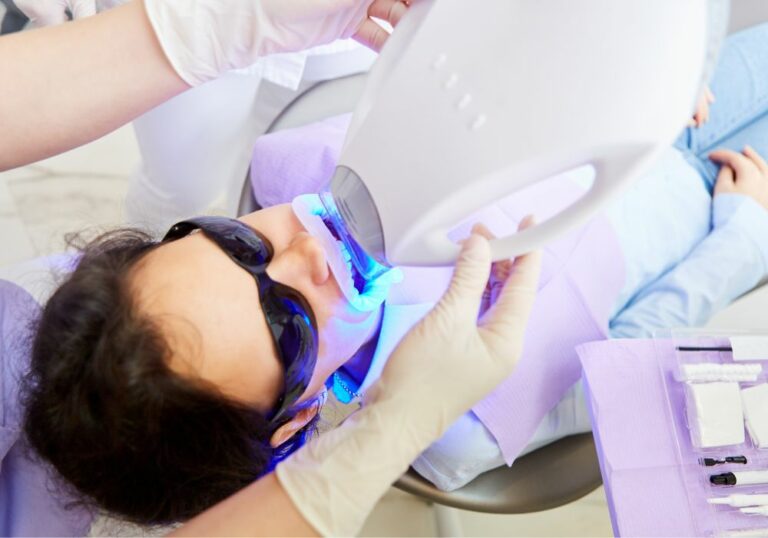Having a bright, white smile can do wonders for your appearance and self-confidence. But many people find that while their top front teeth look nice and pearly white, their bottom teeth appear much yellower in comparison. This is actually a very common situation that can result from some natural differences in the composition and placement of your upper and lower teeth.
Understanding the causes behind this phenomenon is the first step to maintaining the whitest smile possible. In this comprehensive guide, we’ll examine the structural factors that make bottom teeth more prone to yellowing, look at lifestyle habits that can worsen discoloration, go over effective prevention tips, and discuss when to seek professional help for tooth color changes.
Key Reasons for Yellow Lower Teeth

Your bottom teeth are at a disadvantage when it comes to resisting stains due to a few important anatomical differences:
Thinner Tooth Enamel
Enamel is the strong, shiny, pale-colored outer surface of a tooth. It contains high mineral content and less organic material, making it more resistant to staining than other tooth layers. Enamel also protects the softer inner layers of your teeth.
Unfortunately, enamel tends to be thinner on the bottom teeth compared to the tops. This means your lower teeth have less of enamel’s stain-blocking power, allowing discoloring substances to penetrate into the more porous under layers more easily.
Over time, as enamel thins from aging and acidic foods, even more of the yellowish dentin underneath shows through. This leads to a darker yellow hue taking over the appearance of your bottom teeth.
More Exposure of Inner Tooth Layers
Underneath the enamel layer is a softer tissue called dentin. Dentin contains less mineral content and more yellow-pigmented organic material than enamel. As enamel thins and recedes with age, more of this yellowy dentin is exposed on the tooth surface, causing a yellower coloration. This dentin exposure occurs at faster rates on the lower teeth.
In some cases, the whole enamel layer can be worn away, revealing the innermost tooth layer called the pulp chamber. Since the pulp contains nerves and blood vessels, it has an even stronger yellow-orange cast that makes teeth appear very discolored. This severe enamel loss is most common on the backside (tongue side) of bottom teeth.
Reduced Saliva Contact and Washing
Saliva helps cleanse your mouth and teeth by washing away food debris and neutralizing cavity-causing acids. This rinsing action helps prevent stains from setting into the tooth enamel.
Since the lower teeth are located beneath the tongue, they have less exposure to saliva than the more exposed upper teeth. With less saliva contact, staining substances can more readily adhere to and discolor the enamel of your bottom teeth.
Gum Line Comparisons
The natural pinkish-red hue of healthy gums can also influence how light or yellow your teeth appear. The higher visibility of gums beneath lower teeth essentially creates a pink backdrop. In contrast, the whiter whites of your upper teeth stand out more against the paler skin tone above. This color juxtaposition can visually accentuate any yellowing present on your bottom teeth.
Habits and Conditions that Worsen Yellowing
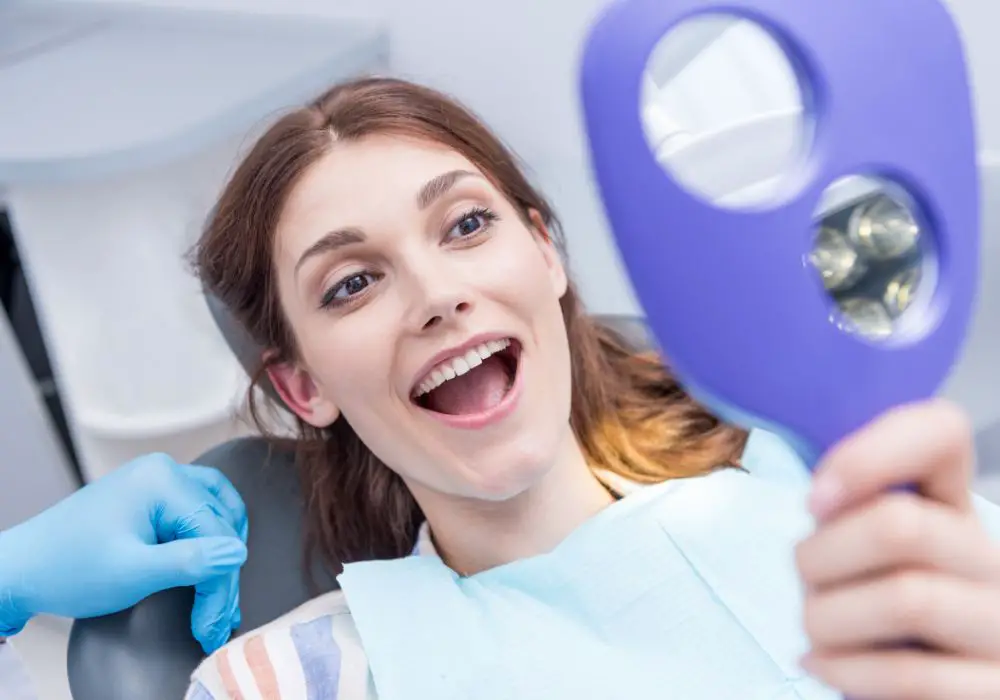
On top of the inherent structural disadvantages of lower teeth, certain lifestyle factors and health issues can compound discoloration problems:
Tobacco Use
Cigarette smoking or chewing tobacco are major causes of significant tooth staining and yellowing. Tobacco products contain many chemicals that penetrate deep into tooth enamel and dentin, leaving behind stubborn brownish/yellowish discoloration.
Since the thinner enamel of lower teeth allows deeper penetration of these staining compounds, heavy tobacco use can really exacerbate the yellowish gap between your upper and lower teeth.
Food and Drink Staining
Dark-colored beverages like coffee, tea, cola, and red wine are common culprits of surface stains on teeth. Sugary foods can also cause enamel damage. As discussed earlier, these staining substances have an easier time adhering to and soaking into the lower teeth.
Limiting consumption of highly pigmented drinks and sugary foods can help curb staining. Promptly brushing or rinsing your mouth after eating/drinking them prevents the stains from setting in and bonds to your enamel.
Dry Mouth Conditions
Having reduced saliva flow, also known as xerostomia, deprives your teeth of saliva’s cleansing effects. Certain medications like antihistamines, hypertension drugs, and antidepressants can cause chronic dry mouth. Health issues like diabetes, vitamin deficiencies, and autoimmune disorders also inhibit saliva production.
Without sufficient saliva washing, your lower teeth are even more susceptible to accelerated staining and plaque buildup. This allows discoloring bacterial byproducts to adhere onto your enamel.
Gum Line Receding
As you age, your gums can naturally recede or pull away from your teeth. This exposes more of the yellowish dentin layer near the gum line of your bottom teeth, creating a darkened appearance along the edges.
Aggressive brushing and periodontal disease can worsen gum recession. See your dentist promptly if you notice your gum line moving away from your lower teeth.
Cracks and Fractures
Cracked or fractured teeth provide a direct route for stains to seep below the enamel layer into the dentin. Since bottom teeth endure more chewing pressures, they are more prone to fractures and cracks than upper teeth.
Small cracks are often painless initially but can rapidly progress into major decay and discoloration if left unrepaired. Visible cracks and fractures require immediate dental work to prevent worsening staining and more severe complications.
Preventive Measures and Home Remedies
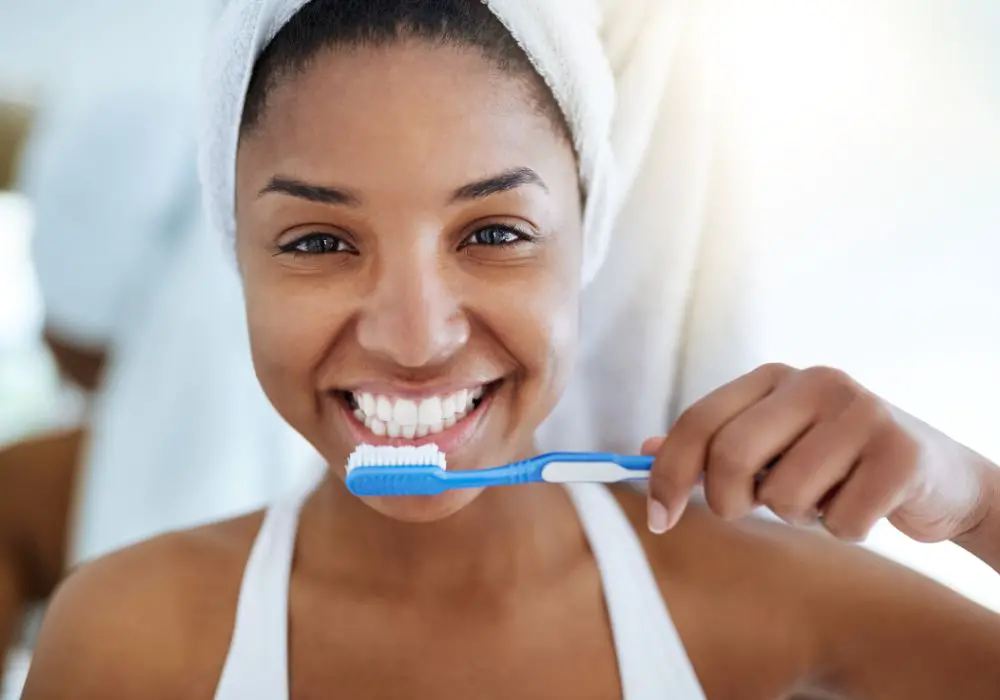
While you can’t change intrinsic tooth composition and structure, implementing prevention strategies and healthy oral care habits can help minimize yellowing of your bottom teeth:
Maintain Impeccable Brushing and Flossing
Meticulous oral hygiene is key to combating bottom tooth yellowing. Brushing and flossing thoroughly removes tooth-staining bacteria, plaque, and tartar from the surfaces of your lower teeth before they can discolor the enamel.
Be sure to carefully brush the tongue side of your bottom teeth which is harder to reach but more vulnerable to yellowing. Use a soft or ultra-soft bristled brush to avoid damaging enamel. Floss at least once daily to clear away debris between your lower teeth.
Rinse After Stain-Causing Drinks and Foods
Whenever you consume dark-pigmented foods and beverages, make a habit of rinsing your mouth afterwards. Swirl water around to wash away staining residues before they set into the enamel of your lower teeth. Finish meals with water or chew sugarless gum to generate more cleansing saliva.
Avoid Tobacco and Limit Stain Promoters
Do your best to quit smoking and tobacco chewing to prevent severe brownish dental stains. Also moderate consumption of coffees, teas, soda, and red wine which encourage less severe surface discoloration.
Use Teeth Whitening Rinses
Over-the-counter whitening mouthwashes contain hydrogen peroxide that helps lift surface stains from your enamel. Swish them around especially on your lower teeth as part of your oral care routine. Just take care not to overuse them as too much peroxide can damage enamel over time.
Schedule Regular Dental Cleanings
Tartar and stubborn stains that daily brushing can’t remove will be eliminated by professional cleaning. A dental hygienist also removes irritating calculus deposits below the gum line and polishes away external stains for whiter-looking teeth. Get a cleaning done every 6 months.
Invest in Professional Whitening Treatments
For significant discoloration or uneven yellowing between upper and lower teeth, in-office or custom-tray whitening kits overseen by your dentist can dramatically brighten your smile. Professional methods are the strongest way to reduce the yellowish cast on heavily stained bottom teeth.
Get Dental Restorations if Needed
For individual teeth with severe cracks, fractures, decay, or enamel loss causing major yellowing, dental restorations like veneers, bonding, or crowns can mask the underlying problem. Artificial coverings essentially create a new enamel surface that conceals inner tooth stains.
When to See Your Dentist
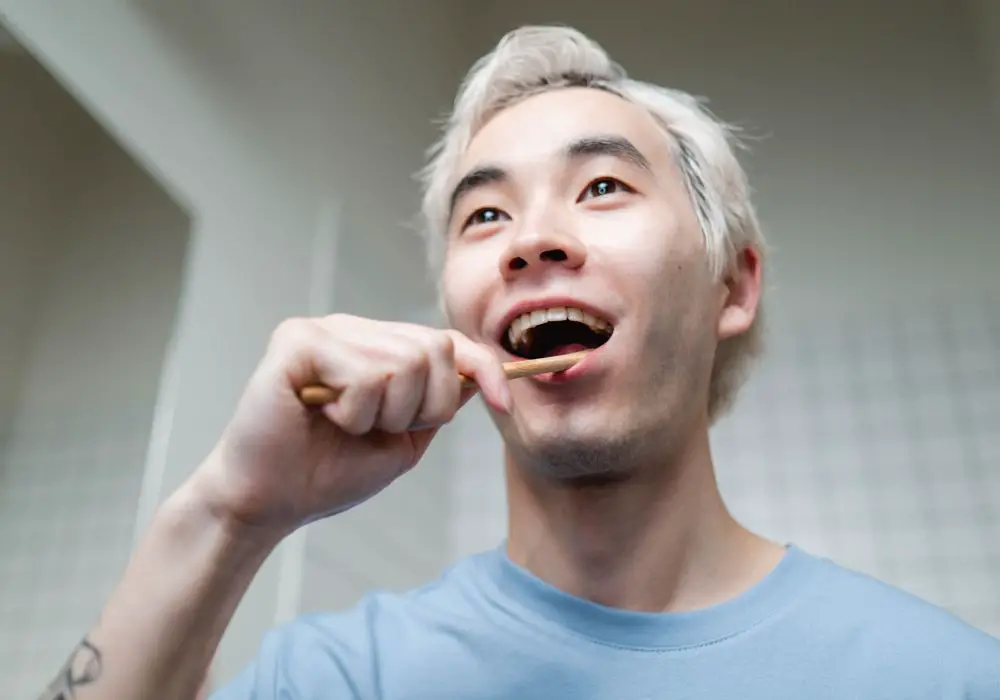
Make an appointment with your general dentist if you notice any of the following:
- Sudden or rapidly worsening yellowing of lower teeth
- Increased sensitivity, pain, or swollen/bleeding gums around discolored teeth
- White, brown, or black spots appearing on teeth
- Visible cracks, fractures, or chippings in teeth
- Exposed inner tooth layers or cavities
- Chronic dry mouth and reduced saliva flow
Significant or abrupt tooth color changes, as opposed to gradual age-related yellowing, could indicate an underlying dental health issue needing prompt care. The dentist can identify causes like dental infections, injuries, oral diseases, and side effects of medications. Catching problems early is critical to prevent permanent tooth damage and greater aesthetic concerns.
The Bottom Line
It’s quite common for the lower teeth to appear yellower than the upper teeth due to thinner enamel, more dentin visibility, reduced saliva exposure, and gum line contrast. Staining foods, tobacco, inadequate hygiene, and dental trauma can worsen discoloration of lower teeth over time.
While some natural color variation is to be expected, proactively preventing yellowing through dental care, stain avoidance, and professional whitening can help you maintain a whiter, brighter smile. Pay attention to any unusual tooth color changes and see a dentist promptly to diagnose and resolve any potential underlying causes.
Frequently Asked Questions
Q: Why are my lower front teeth more yellow than my top front teeth?
A: This is very common and mainly results from thinner enamel and more dentin exposure on your bottom teeth. Your lower teeth are also harder to keep clean and have less contact with saliva to rinse away stains. These inherent factors cause your lower front teeth to appear yellower.
Q: Can brushing more reduce the yellowing of my bottom teeth?
A: Yes, brushing thoroughly at least twice a day can help minimize staining on your bottom teeth. Focus especially on the tongue-side surfaces which are harder to clean but more prone to discoloration. However, brushing alone won’t resolve the natural color variation from thinner enamel.
Q: Is it possible to whiten just my bottom teeth?
A: While home whitening strips and rinses can improve your bottom tooth color, they may not be strong enough to match the whiteness of your top teeth. In-office professional whitening concentrated specifically on the lower teeth can better even out the color discrepancy between upper and lower teeth.
Q: Why do my bottom teeth look yellow even though I don’t smoke?
A: Dark yellowing related to smoking is just one potential cause. The thinner enamel, more dentin exposure, and reduced saliva contact of lower teeth make them prone to yellowing even without tobacco use. Limiting other staining foods and drinks can help minimize yellowing over time.
Q: What is the best way to prevent yellowing of my bottom teeth?
A: Stringent oral hygiene through twice-daily brushing and daily flossing is key to keeping the surfaces of your bottom teeth free of staining buildup. Rinsing with water and using whitening mouthwashes also helps prevent discoloration. Seeing your dentist regularly allows them to detect any early signs of decay that could cause yellowing.

